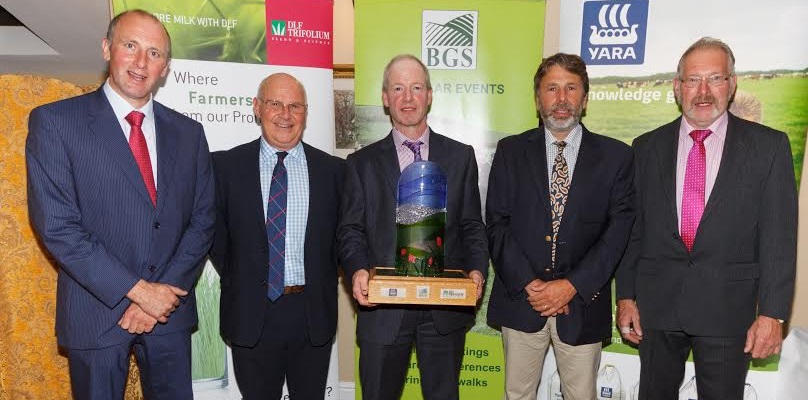
Colin Boggs, a dairy farmer from Co. Down has won the UK Grassland Farmer of the Year Award, run annually by the British Grassland Society (BGS).
The society’s president Dr. Jon Moorby, along with representatives of competition sponsors Yara and DLF Trifolium, announced the winner at a dedicated awards ceremony, near Machynlleth, Wales.
The event was hosted by Bro Dyfi Grassland Society, where last year’s winner organic sheep and beef farmer Dafydd Jones is a member.The runners-up were dairy farmer Gethin Brown from Pembrokeshire and Ralph Messenger, an organic beef farmer from Dorset.
Head judge Glasnant Morgan, a sheep and beef farmer and former award winner, commended all three finalists for getting through three tough previous rounds of the competition, which begins at a local level.
“Each of the finalists has displayed a true commitment and focus to their grassland management and this has been the driving force behind their profitable and sustainable businesses,” said Mr. Morgan.
The praise was echoed by fellow judges Nigel Hester of Yara and Paddy Jack of DLF Trifolium.
The competition, which is open to full BGS members and nominations from local grassland societies from across the UK, scrutinisesthe farmers’ approach to areas such as grazing, crop nutrition, reseeding policy, silage-making and environmental management, as well as their overall business strategy, success and philosophy.
Winner’s details
Colin Boggs runs a 120-cow herd at Clover Hill Farm near Banbridge, Co. Down. Producing a rolling average of 6,530 litres per cow at 4.35% butterfat and 3.50% protein,666kg concentrates are fed per cow (0.1kg per litre), giving an impressive 5,161 litres from forage.
Mr. Boggs attention to grazing management has much to do with his success. He aims to turn out as early as possible and keep grass at the leafy stage throughout, using rotational paddocks and pre-mowing from the second grazing until the end of the growth season.
Towards the end of the season grass is zero-grazed, meaning that grass grown further away can be used, which keeps fresh grass in the diet whilst also maintaining a high level of utilisation.
Calving from mid-January until mid-April, cows were out this year on 14 March by day and 5 April by night. Mr. Boggs aims to make the best silage possible to contribute to winter feeding, taking the first cut this year in the third week of May.
All of the pastures are sown with varieties from the Northern Ireland Recommended List, and Mr. Boggs feels that pre-mowing helps them last longer. He makes good use of free nutrient planning tools to ensure cost-efficiency of inputs versus outputs.
Mr. Boggs also demonstrates commitment to continuing the development of his own skills for business, having recently completed a business management course. He also attends discussion groups and participates in the DARNI Grass Check scheme.
More on the runners-up
The runners-up include another dairy farmer, influenced by the New Zealand grass-based model, and an organic beef producer who is making encouraging use of multi-species leys.
Gethin Brown, Pembrokeshire
Mr. Brown farms 280ha (691 acres) in south Pembrokeshire for James Bros Dairy, encompassing wetlands and sand-dunes, with 80% of the land falling into an NVZ. Grass measurement is central to many decisions made in the business, from how much concentrate to supply, when to cut paddocks for silage and which to reseed. A methodical approach is taken, with all grassland measured weekly, followed by a review meeting with the team.
Mr. Brown maximises value in his product by supplying a cheese contract, and only uses concentrate where there is shortfall in grass – not as a means to increasing yield.
A proportion of the farm is rented from the National Trust, with areas open to the public attracting over 300,000 visitors per year, and 25ha (62 acres) in environmental schemes to encourage wild birds.
Ralph Messenger, Dorset
Mr. Messenger keeps 150 Aberdeen Angus beef suckler cows at Manor Farm, finishing heifers, steers and young bulls at a deadweight of 325kg, mainly forage derived.
Ryegrass/clover swards, undersown whole crop silage, and herbal leys and home-grown rolled barley all contribute to the feed. Grass/clover silage is available ad-lib to fat cattle from July, whilst wholecrop silage is reserved for cows, calves and replacements. Herbal leys are strip grazed throughout the year and wetland areas under HLS are also useful in drought conditions.
Mr. Messenger’s choice to farm organically has been in part due to a keen interest in promoting wader birds with water rail, snipe, little egret, cormorants and herons among those visiting the farm.
